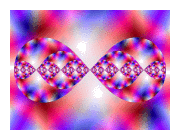
Fractals:
Pictures of Chaos
 |
Fractals:
|
|
Valuable Sites to Visit:
|
Mathematically, fractals are pictures that result from iterations of nonlinear equations, usually in a feedback loop. Using the output value for the next input value, a set of points is produced. Graphing these points produces images. Again, by creating a vast number of points using computers to generate those points, mathematicians discovered these wonderfully complex images which were called fractals, a term coined by Benoit Mandelbrot, one of the first to discover and examine these images. Two important properties of fractals are:
Self-similarity means that at every level, the fractal image repeats itself. Sierpinski's Triangle demonstrates this quite well: a triangle within smaller triangles within smaller triangles within ever smaller triangles, on and on. Many shapes in nature display this same quality of self-similarity. Clouds, ferns, coastlines, mountains, etc. all possess this feature. Fractional dimension means that a shape is neither 1, 2 or 3 dimensional, but actually may fall between these numbers, being composed of fractions. Mandelbrot calculated that fractals have a fractional dimension between 1 and 2. By studying fractals, mathematicians have a whole new geometry for describing the universe, beyond the boundaries of Euclidean geometry. Euclidean geometry allowed us to study and understand regular shapes: polyhedrons and circles. But very little in nature is so regular. Just as with algebra, where we continued to bang our heads against the need to understand and solve nonlinear equations in order to model most universal systems, we continue to bang our heads against the need to understand irregular shapes using a geometry that could accommodate the complexities of these shapes. Fractals mirror these irregular shapes, thereby allowing us to study and understand nature by understanding fractals. Fractals are the place where math, science and art come together. They visually demonstrate the relationships between disparate parts of the universe; they demonstrate the interdependence of all things in nature. They allow us to view the complexity of chaos and order. They please us visually and excite our imaginations. That is why there is an abundance of sites on fractals. I've only provided the smallest list of fractal galleries. Use "fractal" as a keyword in any of the major search engines, and you will find much more than you need. However, I suggest you start with the Math Forum's listing on fractals. Activities:
Fractal Galleries:
|
|
|
|
|
|
|
|
|
|
 |
| author: Kelleen Farrell | 1280 Roxie Court | Placerville, CA 95667 |
| copyright (c) 1998 | 530-295-0680 | 209-257-5537 |